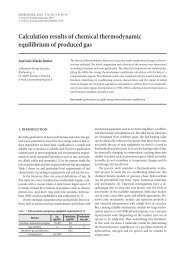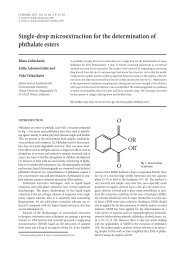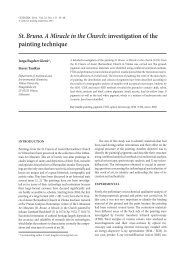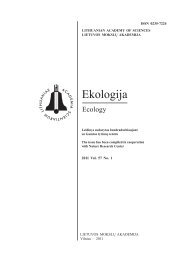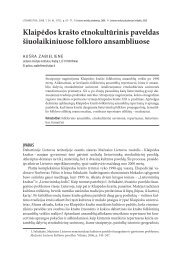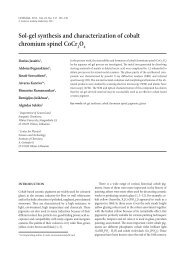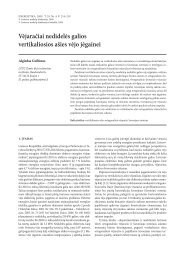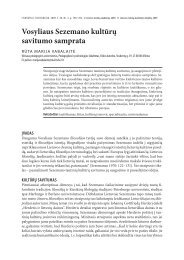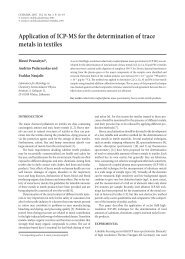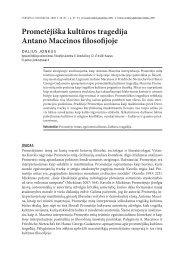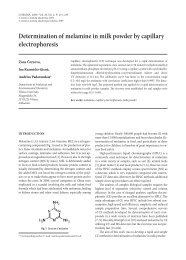The enzymatic reduction of pyridine N-oxide derivatives - Lietuvos ...
The enzymatic reduction of pyridine N-oxide derivatives - Lietuvos ...
The enzymatic reduction of pyridine N-oxide derivatives - Lietuvos ...
Create successful ePaper yourself
Turn your PDF publications into a flip-book with our unique Google optimized e-Paper software.
chemija. 2009. vol. 20. No. 1. P. 33–37© lietuvos mokslų akademija, 2009© lietuvos mokslų akademijos leidykla, 2009<strong>The</strong> <strong>enzymatic</strong> <strong>reduction</strong> <strong>of</strong> <strong>pyridine</strong> N-<strong>oxide</strong> <strong>derivatives</strong>:the role <strong>of</strong> their electron accepting potencyRomualdas Striela 2 ,Lina Misevičienė 2 ,Olga Gedrimaitė 3 ,Linas Labanauskas 2, 3 ,Gintaras Urbelis 1, 2 ,Jonas Šarlauskas 2 ,Narimantas Čėnas 2 ,Žilvinas Anusevičius 2 *1Faculty <strong>of</strong> Chemistry, Vilnius University,Naugarduko 24, LT-03225 Vilnius, Lithuania2Institute <strong>of</strong> Biochemistry,Mokslininkų 12, LT-08662 Vilnius, Lithuania<strong>The</strong> <strong>reduction</strong> reactions <strong>of</strong> a series <strong>of</strong> <strong>pyridine</strong>- and nitro<strong>pyridine</strong>-N-<strong>oxide</strong> compoundsby single-electron transferring flavoenzyme Anabaena PCC 7119 ferredo xin-NADP + oxidoreductase(FNR, EC 1.18.1.2) were examined. <strong>The</strong> steady-state bimolecular rate constants(k cat/ K m) <strong>of</strong> the <strong>reduction</strong> <strong>of</strong> <strong>pyridine</strong> N-<strong>oxide</strong>s were determined to range between1.3 × 10 1 and 2.0 × 10 4 M –1 s –1 . <strong>The</strong> quantitative structure activity relationships (QSARs)were defined between the logarithm <strong>of</strong> the k cat/ K mparameter <strong>of</strong> the compounds’ <strong>reduction</strong>and the energies <strong>of</strong> their lowest unoccupied molecular orbitals (E LUMO) obtained byquantum-mechanical methods. QSARs studies showed that the reactivity <strong>of</strong> <strong>pyridine</strong> N-<strong>oxide</strong> <strong>derivatives</strong> was generally higher than that <strong>of</strong> nitroaromatic model compounds. <strong>The</strong><strong>pyridine</strong> N-<strong>oxide</strong> as well as nitro<strong>pyridine</strong> N-<strong>oxide</strong> <strong>derivatives</strong> proved to be more efficientsubstrates for the single-electron flavin-dependent enzyme than the model nitroaromaticsand thus can be attributed to a new series <strong>of</strong> closely related compounds. This preliminarystudy may serve as a useful tool for predicting the <strong>enzymatic</strong> reactivity <strong>of</strong> structurallyrelated compounds and may be used for analysis <strong>of</strong> their cytotoxicity with respect tothe possible involvement <strong>of</strong> their redox cycling.Key words: <strong>pyridine</strong> N-<strong>oxide</strong>s, lowest unoccupied molecular orbital, electron transfer,ferredoxin reductase, quantitative structure activity relationship3Institute <strong>of</strong> Chemistry,Goštauto 9, LT-01108 Vilnius, LithuaniaINTRODUCTION<strong>The</strong> application <strong>of</strong> N-<strong>oxide</strong> <strong>derivatives</strong> received considerableattention due to their usefulness as synthetic intermediatesand biological importance. Heterocyclic N-<strong>oxide</strong>s are alsouseful as protecting groups, auxiliary agents, oxidants, ligandsin metal complexes and catalysts [1]. Pyridine N-<strong>oxide</strong>sare intensively used as precursors for the synthesis <strong>of</strong> corresponding<strong>pyridine</strong>s, tetrazolo[1,5-a]<strong>pyridine</strong>s and stereodefineddienal oximes compounds [2–4]. Pyridine N-<strong>oxide</strong>stake part in reaction with Grignard reagents [2, 5] and areused as organocatalysts for the asymmetric allylation <strong>of</strong> aldehydes[6]. <strong>The</strong>y can be functionalized by palladium or nickelcatalyst [5, 7]. <strong>The</strong> oxidation <strong>of</strong> <strong>pyridine</strong>s to their N-<strong>oxide</strong>s isemployed in drug discovery programs [8]. Pyridine N-<strong>oxide</strong><strong>derivatives</strong> represent a new class <strong>of</strong> anti-HIV compounds, for* Corresponding author. E-mail: zilvinas@bchi.ltwhich some <strong>of</strong> the members exclusively act through inhibition<strong>of</strong> HIV-1 reverse transcriptase and thus behave as thenon-nucleoside reverse transcriptase inhibitors [10]. <strong>The</strong> <strong>oxide</strong>part <strong>of</strong> the <strong>pyridine</strong> moiety proved to be indispensable foranti-coronavirus activity. <strong>The</strong> potency and virus specificity <strong>of</strong>the <strong>pyridine</strong> N-<strong>oxide</strong>s were shown to vary depending on thenature and location <strong>of</strong> alkyl, halogen, nitro and other substituentson the molecule [10]. <strong>The</strong> carcinogenicity and mutagenicity<strong>of</strong> 4-nitro<strong>pyridine</strong> N-<strong>oxide</strong> and its <strong>derivatives</strong> weretested on mice, Salmonella typhimurium and Escherichia colistrains. However, no clear quantitative relationship betweenmutagenicity and carcinogenicity was found among the compoundsexamined [11]. <strong>The</strong> ames test <strong>of</strong> <strong>pyridine</strong> N-<strong>oxide</strong>son Salmonella typhimurium strains showed a mutagenic actionwithout metabolic activation [12]. Some N-<strong>oxide</strong> <strong>derivatives</strong>may act as bioreductive drugs [13]. <strong>The</strong> toxicity <strong>of</strong> thesecompounds was found to be exerted via intracellular metabolismto highly toxic radicals. At a low oxygen level, N-<strong>oxide</strong>
34Romualdas Striela, Lina Misevičienė, Olga Gedrimaitė et al.compound radicals react with cellular molecules, causingDNA damage and cell death. In aerobic cells, the toxicity <strong>of</strong>these compounds results from the back-oxidation <strong>of</strong> theirradicals by molecular oxygen [13].<strong>The</strong> objective <strong>of</strong> this work was to carry out a preliminarystudy <strong>of</strong> <strong>pyridine</strong> N-<strong>oxide</strong> <strong>derivatives</strong> as redox activesubstrates in reactions with Anabaena PCC 7119 NADP + –ferredoxin reductase (FNR, EC 1.18.1.2) used as a modelelectron transferring flavoenzyme. We have attemptedto define the quantitative structure activity relationship(QSAR) between the <strong>enzymatic</strong> reactivity <strong>of</strong> compoundsand their electron accepting potency expressed as the energy<strong>of</strong> the lowest unoccupied molecular orbitals. This mayserve as a useful tool for predicting the reactivity <strong>of</strong> relatedcompounds and may be used in future for the analysis <strong>of</strong>their cytotoxicity with respect to the possible involvement<strong>of</strong> their redox cycling.EXPERIMENTALChemicals and enzyme. <strong>The</strong> structural formulas <strong>of</strong> <strong>pyridine</strong>N-<strong>oxide</strong> <strong>derivatives</strong> are presented in Fig. 1. 2,3-Dimethyl<strong>pyridine</strong>N-<strong>oxide</strong> (1) was prepared from 2,3-dimethyl<strong>pyridine</strong>using the oxidation procedure with hydrogen per<strong>oxide</strong> inacetic acid as described in [14] (m. p. 95–96 °C, 1 H-NMR(CDCl 3) δ(ppm): 2.29 (s, 3H), 2.45 (s, 3H), 6.94–7.04 (m, 2H),8.09–8.13 (m, 1H)). Pyridine N-<strong>oxide</strong> (2) (m. p. 66–68 °C,1H-NMR (CDCl 3) δ(ppm): 7.30–7.37 (m, 3H), 8.23–8.31(m, 2H), 4-chloro<strong>pyridine</strong> N-<strong>oxide</strong> (3) (m. p. 169–170 °C, 1 H-NMR (CDCl 3) δ(ppm): 7.23–7.33 (m, 2H), 8.11–8.20 (m, 2H)and 4-nitro<strong>pyridine</strong> N-<strong>oxide</strong> (8) (m. p. 160–162 °C, 1 H-NMR(CDCl 3) δ(ppm): 8.06–8.12 (m, 2H), 8.20–8.26 (m, 2H)) weresynthesized by the methods reported in [15]. 4-Chlo ro-2,3-dimethyl<strong>pyridine</strong> N-<strong>oxide</strong> (4) was obtained starting with 2,3-dimethyl-4-nitro<strong>pyridine</strong> by reaction with hydrochloric acidas described in [16] (m. p. 104–105 °C). 1 H-NMR (CDCl 3)δ(ppm): 2.35 (s, 3H), 2.51 (s, 3H), 7.11 (d, 1H J = 6.9 Hz),8.06 (d, 1H J = 6.9 Hz)). 2,3-Dimethyl-4-nitro<strong>pyridine</strong> N-<strong>oxide</strong>(5) was synthesized according to the des cri bed method[17] (m. p. 91–92 °C). 1 H-NMR (CDCl 3) δ(ppm): 2.57 (d,6H J = 6 Hz), 7.70 (d, 1H J = 7.2 Hz), 8.20 (d, 1H J = 7.2 Hz)).2-Chloro-3-methoxy-6-nitro<strong>pyridine</strong> N-<strong>oxide</strong> (6) was preparedfrom 2-chloro-3-methoxy<strong>pyridine</strong> N-<strong>oxide</strong> by the methoddescribed in [18] (m. p. 103–105 o C. 1 H-NMR (CDCl 3) δ(ppm):4.12 (s, 3H), 7.83 (d, 1H J = 7.5 Hz), 8.23 (d, 1H J = 7.5 Hz).2-Bromo-3-methoxy-6-nitro<strong>pyridine</strong> N-<strong>oxide</strong> (7) was obtainedby a published method [18] (m. p. 140–142 o C. 1 H-NMR(CDCl 3) δ(ppm): 4.10 (s, 3H), 6.92 (d, 1H J = 9 Hz),7.35 (d, 1H J = 9 Hz)). NADPH and cytochrome C were purchasedfrom Reanal and Sigma, respectively. Anabaena PCC7119 ferredoxin : NADP + reductase was prepared as describedpreviously [19] and was a generous gift <strong>of</strong> Dr. Martinez-Julvezand Pr<strong>of</strong>essor C. Go mez-Moreno (Zaragoza University,Spain). <strong>The</strong> enzyme concentration was determined accordingto the absorbance <strong>of</strong> FAD, ε 459= 9.4 mM –1 cm –1 [20].Enzymatic assay. <strong>The</strong> kinetic measurement <strong>of</strong> FNR-catalyzed<strong>reduction</strong> <strong>of</strong> <strong>pyridine</strong> N-<strong>oxide</strong>s was carried out spectrophotometricallyusing a Hitachi-557 spectrophotometer in 0.1 MK-phosphate buffer containing 1 mM EDTA at 25 °C. <strong>The</strong>rates were monitored by following the oxidation <strong>of</strong> NADPH(∆ε 340= 9.4 mM –1 cm –1 ). <strong>The</strong> rates obtained were correctedfor intrinsic NADPH : oxidase activity <strong>of</strong> enzyme. To 2 ml <strong>of</strong>the reaction mixture, 10–20 µl solution <strong>of</strong> the <strong>pyridine</strong> N-<strong>oxide</strong>substrates dissolved in DMSO was added to start the reaction.<strong>The</strong> FNR concentration varied between 25 and 50 nM.As it was tested previously, 1–2% <strong>of</strong> DMSO in the enzymereaction mixture do not influence the kinetic experiments[21]. In separate experiments, the <strong>reduction</strong> <strong>of</strong> cytochrome c(50 µM) in the presence <strong>of</strong> NADPH and <strong>pyridine</strong> N-<strong>oxide</strong> wasmonitored using ∆ε 550= 19.2 mM –1 cm –1 .Fig. 1. Structural formulae <strong>of</strong> <strong>pyridine</strong> N-<strong>oxide</strong> compounds used in this study
<strong>The</strong> <strong>enzymatic</strong> <strong>reduction</strong> <strong>of</strong> <strong>pyridine</strong> N-<strong>oxide</strong> <strong>derivatives</strong>: the role <strong>of</strong> their electron accepting potency35Assuming a ping-pong reaction scheme for FNR [21], thekinetic parameters were determined at fixed concentration<strong>of</strong> NADPH (100 µM) and varied concentrations <strong>of</strong> <strong>pyridine</strong>N-<strong>oxide</strong> substrates. Typically, 6–8 concentrations <strong>of</strong> compoundswere used. Due to a limited solubility or a high opticaldensity <strong>of</strong> the compounds at their higher concentrations,a function <strong>of</strong> the following form was fitted to the experimentaldata [22]:v / [E 0] = k cat/ K m(PyNO){[PyNO] / / (1 + [PyNO] / K m(PyNO)}, (1)where v, [E 0] and K m(PyNO)respectively are the initial rate <strong>of</strong>NADPH oxidation, the total FNR concentration and theMichaelis–Menten constant for the <strong>reduction</strong> <strong>of</strong> <strong>pyridine</strong>N-<strong>oxide</strong> substrate [PyNO]. This function represents a reparameterizedMichaelis–Menten equation which permits anaccurate calculation <strong>of</strong> the k cat/ K m(PyNO)ratio even when thek catand K m(PyNO)parameter values cannot be determined separately[22]. In situations when [PyNO] / K m(PyNO)
36Romualdas Striela, Lina Misevičienė, Olga Gedrimaitė et al.Table. <strong>The</strong> bimolecular rate constants (k cat/ K m) <strong>of</strong> FNR-catalyzed <strong>reduction</strong> <strong>of</strong> <strong>pyridine</strong> N-<strong>oxide</strong> <strong>derivatives</strong> and nitroaromatic model compounds, and theirE LUMOvalues as calculated by semi-empirical AM1 and PM3 methodsNo.Compoundk cat/ K EmLUMO(eV)(M –1 · s –1 )RHF / AM1RHF / PM3Pyridine-N-<strong>oxide</strong>s1 2,3-Dimethyl<strong>pyridine</strong> N-<strong>oxide</strong> 1.3 ± 0.1 × 10 1 –0.28 –0.532 Pyridine-N-<strong>oxide</strong> 6.8 ± 1.4 × 10 1 –0.33 –0.593 4-Chloro-<strong>pyridine</strong>-N-<strong>oxide</strong> 2.4 ± 0.4 × 10 2 –0.62 –0.794 4-Chloro-2,3-dimethyl<strong>pyridine</strong>-N-<strong>oxide</strong> 7.1 ± 0.9 × 10 2 –0.51 –0.725 4-Nitro-2,3-dimethyl<strong>pyridine</strong>-N-<strong>oxide</strong> 3.7 ± 0.9 × 10 3 –1.55 –1.386 2-Chloro-3-methoxy-6-nitro<strong>pyridine</strong> N-<strong>oxide</strong> 8.8 ± 0.4 × 10 3 –1.28 –1.447 2-Bromo-3-methoxy-6-nitro<strong>pyridine</strong> N-<strong>oxide</strong> 1.2 ± 0.2 × 10 4 –1.29 –1.418 4-Nitro<strong>pyridine</strong> N-<strong>oxide</strong> 2.0 ± 0.3 × 10 4 –1.70 –1.61Nitroaromatic compounds9 Nitrobenzene 5.9 ± 0.5 × 10 1 –1.07 –1.1310 4-Nitrobenzyl alcohol 1.4 ± 0.1 × 10 2a –1.20 –1.2611 4-Nitrobenzaldehyde 8.3 ± 0.7 × 10 3b –1.67 –1.6912 1,2-Dinitrobenzene 2.2 ± 0.2 × 10 3b –1.84 –1.8513 1,3-Dinitrobenzene 2.5 ± 0.2 × 10 3b –1.91 –1.9614 1,4-Dinitrobenzene 3.0 ± 0.2 × 10 4b –2.21 –2.2515 2,4,6-Trinitrotoluene 1.1 ± 0.1 × 10 4c –2.43 –2.45a, b, cObtained from our previous papers [21, 33–35]. K mrefers to K m<strong>of</strong> <strong>pyridine</strong> N-<strong>oxide</strong> <strong>derivatives</strong> or nitroaromatic model compounds.tends to increase with an increase in their negative E LUMOvalues. In order to define the structure activity relationships(QSAR), the logarithm <strong>of</strong> the k cat/ K m(PyNO)was plottedagainst their E LUMOvalues. A clear correlation was obtainedby the semi-empirical PM3 method (R = 0.95, F = 55.85),and a slightly less pronounced correlation was defined by theAM1 method (R = 0.92, F = 32.27). In our further studies,we have compared the reactivities <strong>of</strong> <strong>pyridine</strong> N-<strong>oxide</strong>s withthose <strong>of</strong> nitroaromatic model compounds. As determined inour previous work [21], the reactivity <strong>of</strong> nitroaromatics inFNR-catalyzed reactions correlated with their E 1 values, and7these reactions were analysed within the framework <strong>of</strong> the“outer-sphere” electron transfer model. This means that thereacti vity <strong>of</strong> the compounds is governed by their electronaccepting potency without any substantial influence <strong>of</strong> theirstructural peculiarities. In the present study, we have determinedthat the k cat/ K m<strong>of</strong> nitroaromatic model compoundspoorly match the reactivities <strong>of</strong> <strong>pyridine</strong> N-<strong>oxide</strong> <strong>derivatives</strong>(the resulting QSAR regressions were expressed to a less significantextent (R = 0.79, F = 21.66 and R = 0.78, F = 20.61for AM1 and PM3 methods, respectively)). <strong>The</strong> reactivity <strong>of</strong> aseries <strong>of</strong> <strong>pyridine</strong> N-<strong>oxide</strong> <strong>derivatives</strong> is generally higher thanthat <strong>of</strong> nitroaromatic model compounds (Fig. 2). Thus, the <strong>pyridine</strong>as well as nitro<strong>pyridine</strong> N-<strong>oxide</strong> <strong>derivatives</strong> proved tobe more efficient substrates for the single-electron flavin-dependentenzyme than the model nitroaromatics, and thus canbe attributed to a new series <strong>of</strong> closely related compounds. Inour opinion, the difference in the reactivities <strong>of</strong> <strong>pyridine</strong> N-<strong>oxide</strong> <strong>derivatives</strong> and nitroaromatic model compounds maybe partly explained by differences in their self-exchange rateconstants (k ex). <strong>The</strong> k exfor electron transfer between the radicalanion and a neutral species <strong>of</strong> a nitroaromatic compoundFig. 2. Quantitative structure activity relationships describing a correlationbetween the logarithm <strong>of</strong> bimolecular rate constant (k cat/ K m) <strong>of</strong> <strong>reduction</strong> <strong>of</strong><strong>pyridine</strong> N-<strong>oxide</strong> <strong>derivatives</strong> and nitroaromatic model compounds and their E LUMOvalues. E LUMOdata used were those calculated by semi-empirical PM3 method.<strong>The</strong> numbers <strong>of</strong> compounds are taken from Tableis known to be 10 4 –10 5 M –1 s –1 [31, 32]. Irrespective <strong>of</strong> the factthat the k ex<strong>of</strong> <strong>pyridine</strong> N-<strong>oxide</strong>s has not been determined s<strong>of</strong>ar, it is assumed that the higher reactivity <strong>of</strong> <strong>pyridine</strong> N-<strong>oxide</strong>scan be partly caused by their k exvalue which seems to behigher than that <strong>of</strong> nitroaromatic model compounds.CONCLUSIONSPyridine N-<strong>oxide</strong> <strong>derivatives</strong> in the reactions with electrontransferring flavoenzyme were shown to be efficient redoxactivecompounds. <strong>The</strong> existence <strong>of</strong> quantitative structure activityrelationships for these reactions may prove to be useful
<strong>The</strong> <strong>enzymatic</strong> <strong>reduction</strong> <strong>of</strong> <strong>pyridine</strong> N-<strong>oxide</strong> <strong>derivatives</strong>: the role <strong>of</strong> their electron accepting potency37for predicting the redox activity <strong>of</strong> newly synthesized compounds<strong>of</strong> related structure and may serve as a tool for analysis<strong>of</strong> their cytotoxicity. More thorough quantum chemicaland <strong>enzymatic</strong> studies for a wider range <strong>of</strong> <strong>pyridine</strong> N-<strong>oxide</strong>compounds are under way.AcknowledgementsThis work was supported in part by the Agency for InternationalScience and Technology Development Programmes inLithuania (COST Action CM0603).ReferencesReceived 26 November 2008Accepted 10 December 20081. A. Albini, S. Pietra, Heterocyclic N-<strong>oxide</strong>s. CRC Press: BocaRaton (1991).2. H. Andersson, X. Wang, M. Bjorklund, R. Olsson, F. Almqvist,Tetrahedron Lett. 48, 6941 (2007).3. J. M. Keith, J. Org. Chem. 71, 9540 (2006).4. F. E. Cislak, Ind. Eng. Chem. 47, 800 (1955).5. K. S. Kanyiva, Y. Nakao, T. Hiyama, Angew. Chem. Int. Ed.46, 8872 (2007).6. A. V. Malkov, M. Bell, F. Castelluzzo, P. Kocovsky, Org. Lett.7, 3219 (2005).7. S. H. Cho, S. J. Hwang, S. Chang, J. Am. Chem. Soc. 130,9254 (2008).8. X. Zhu, K. D. Kreutter, H. Hu, M. R. Player, M. D. Gaul,Tetrahedron Lett. 49, 832 (2008).9. J. Balzarini, M. Stevens, E. De Clercq E., D. Schols, C. Pannecouque,J. Antimicrobial Chemother. 55, 135 (2005).10. J. Balzarini, E. Keyaerts, L. Vijgen, F. Vandermeer,M. Ste vens, E. De Clercq, H. Egberink, M. Van Ranst, J.Antimicrobial Chemother. 57, 472 (2006).11. K. Takahashi, G. F. Huang, M. Araki, Y. Kawazoe, J. Aller gyClin. Immunol. 70, 799 (1979).12. C. E. Voogd, J. J. van der Stel, J. J. Jacobs, Mutat. Res. 78,233 (1980).13. B. Ganley, G. Chowdhury, J. Bhansali, J. S. Daniels, K. S. Gates,Bioorg. Med. Chem. 9, 2395 (2001).14. D. Y. Kim, W. T. Jung, S. M. Lee, Drugs Fut. 6, 618 (1999).15. А. Ф. Пожарский, В. А. Анисимова, Е. Б. Цупак, Практическиеработы по химии гетероциклов, Из да тельствоРостовского университета (1988).16. T. C. Kuhler, M. Swanson, V. Shcherbuchin, H. Larsson,B. Mellgard, J. E. Sjostrom, J. Med. Chem. 41, 1777 (1998).17. J. M. Essery, K. Sch<strong>of</strong>ield, J. Chem. Soc. 9, 4953 (1960).18. M. Tiecco, M. Tingoli, L. Testaferri, D. Chianelli, E. Wenkert,Tetrahedron 42, 1475 (1986).19. J. J. Pueyo, C. Gomez-Moreno, Prep. Biochem. 21, 191 (1991).20. M. Medina, M. Martinez-Julvez, J. K. Hurley, G. Tollin,C. Gomez-Moreno, Biochemistry 37, 2715 (1998).21. Ž. Anusevičius, M. Martinez-Julvez, C. G. Genzor, H. Nivinskas,C. Gomez-Moreno, N. Čėnas, Biochim. Biophys.Acta 1320, 247 (1997).22. R. H. Kolm, U. H. Danielson, Y. Zhang, P. Talalay, B. Mannervik,Biochem. J. 311, 453 (1995).23. N. H. P. Cnubben, S. Peelen, J. W. Borst, J. Verwoort, C. Veeger,I. M. C. M. Rietjens Chem. Res. Toxicol. 7, 590 (1994).24. M. J. H. Van Haandel, I. M. C. M. Rietjens, A. E. M. F. S<strong>of</strong>fers,C. Veeger, J. Vervoort, S. Medi, M. S. Mindal, P. K. Patel,D. V. Behere, JBIC 1, 460 (1996).25. Ž. Anusevičius, A. E. M. F. S<strong>of</strong>fers, N. Čėnas, J. Šarlauskas,J. Segura-Aguilar, I. M. C. M. Rietjens, FEBS Lett. 427,325 (1998).26. I. Nikanishi, C. Nishizawa, K. Ohkuba, K. Takeshita,K. T. Suzuki, T. Ozawa, S. M. Hecht, M. Tanno, S. Sueyoshi,N. Miyata, H. Okuda, S. Fukuzumi, N. Ikota, K. Fukuhara,Org. Biomol. Chem. 3, 3263 (2005).27. D. B. Northrop, J. Chem. Education, 75, 1153 (1998).28. Ž. Anusevičius, A. E. M. F. S<strong>of</strong>fers, N. Čėnas, J. Šarlauskas,M. Martinez-Julvez, I. M. C. M. Rietjens, FEBS Lett. 450,44 (1999).29. Ž. Anusevičius, L. Misevičienė, M. Medina, M. Martinez-Jul vez, C. Gomez-Moreno, N. Čėnas, Arch. Biochem. Biophys.437, 144 (2005).30. Ž. Anusevičius, M. Martinez-Julvez, M. Medina, C. Gomez-Moreno,J. Šarlauskas, N. Čėnas, in: S. Zeman (ed.),Proceedings <strong>of</strong> 10th seminar “New Trends in Research <strong>of</strong>Energetic Materials”, Pardubice University (2007).31. P. Wardman, D. E. Clarke, Biochem. Biophys. Res. Commun.69, 942 (1976).32. M. E. Germain, T. R. Vargo, B. A. McClure, J. J. Rack,P. G. Van Patten, M. Odoi, M. J. Knapp, Inorg. Chem. 47,6203 (2008).33. N. Čėnas, A. Nemeikaitė-Čėnienė, E. Sergedienė, H. Nivinskas,Ž. Anusevičius, J. Šarlauskas, Biochim. Biophys.Acta 1528, 31 (2001).34. V. Miškinienė, J. Šarlauskas, J.-P. Jacquot, N. Čėnas,Biochim. Biophys. Acta 1366, 275 (1998).35. J. Šarlauskas, A. Nemeikaitė-Čėnienė, Ž. Anusevičius,L. Misevičienė, M. Martinez Julvez, M. Medina, C. Gomez-Moreno, N. Čėnas, Arch. Biochim. Biophys. 425, 184(2004).Romualdas Striela, Lina Misevičienė, Olga Gedrimaitė,Linas Labanauskas, Gintaras Urbelis, Jonas Šarlauskas,Narimantas Čėnas, Žilvinas AnusevičiusFERMENTINĖ PIRIDINO N-OKSIDO DARINIŲREDUKCIJA: JUNGINIŲ ELEKTRONO AKCEPTORI-NIO PARAMETRO ĮTAKASantraukaPiridino N-oksido darinių redukcijos bei redoks ciklinimo galimybėsbuvo įvertintos naudojant žemo potencialo elektrontransferazinįflavininį fermentą Anabaena PCC 7119 ferredoksin-NADP +oksidoreduktazę (FNR, FK 1.18.1.2). Nustatyti piridino N-oksidodarinių fermentinio reaktingumo ir junginių elektrono akceptoriniųparametrų, apskaičiuotų kvantocheminiais metodais, struktūros–aktyvumoryšiai (SAR). Gauti rezultatai gali būti panaudotitolesniems tyrimams prognozuojant šių bei analogiškų junginiųreaktingumus fermentinėse reakcijose bei citotoksiškumą.



